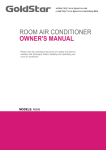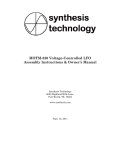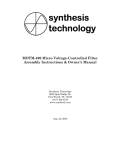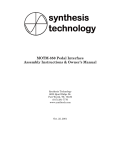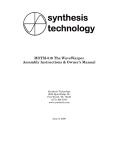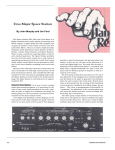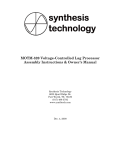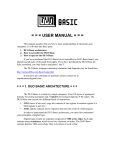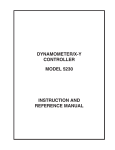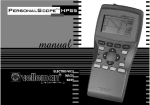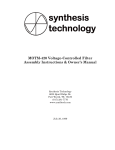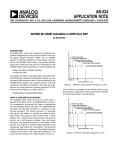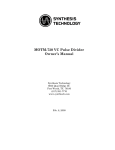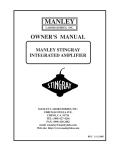Download MOTM-120 User Manual
Transcript
MOTM-120 Sub-Octave Multiplexer Assembly Instructions and User’s Guide Synthesis Technology 6625 Quail Ridge Dr. Fort Worth, TX 76180 (817) 281-7776 www.synthtech.com May, 1999 MOTM-120 PARTS LIST Please carefully check that all parts are in your kit. If you have a suspected shortage, please call or email. If you get free extra stuff, keep it for next time. Capacitor bag, containing the following 18 parts: 3ea 10mfd, 50V Electrolytic C3, C4, C6 3ea 220pf ceramic axial C12, C15, C18 1ea 0.47mfd (470N) yellow box polycarbonate C7 11ea 0.1mfd (104) ceramic axial C1, 2, 5, C8-11, C13, 14, 16, C17 Resistor bag, containing the following 23 parts: 8ea 100K 5% (brown, black, yellow) 7ea 10K 5% (brown, black, orange) 3ea 1K 5% (brown, black, red) 2ea 2M2 5% (red, red, green) 2ea 4M7 5% (yellow, violet, green) 1ea 33K 5% (orange, orange, orange) R4 - R9, R11, R12 R1, R2, R3, R16, R17, R21, R22 R13, R14, R19 R18, R23 R15, R20 R10 IC bag, containing the following 8 parts: 2ea 74HC161 counter 1ea 74HC08 quad AND gate 1ea 74HC157 quad 2:1 mux 2ea LM311 comparator 1ea TL072 dual op amp 1ea LM78L05 5V voltage regulator U1, U2 U3 U5 U7, U8 U6 U4 Misc #1 bag, containing the following 6 parts: 2ea Axial ferrite beads (plain, gray things)L1, L2 3ea SPDT toggle switch SW1, SW2, SW3 1ea MTA-156 power connector JP1 Knobs, 6ea, ALCO PKES90B1/4 Jacks, 3ea Switchcraft 112A SYNTHESIS TECHNOLOGY MOTM-120 ASSEMBLY WWW.SYNTHTECH.COM PAGE 2 PAGE 2 MOTM-120 PARTS LIST Pots, containing the following: 4ea 100K linear, Spectrol 149 2ea 100K linear, Bourns 91 (panel mount) VR1-4 VR5 & VR6 Front panel Mounting bracket Wire bag, containing the following 10 wires: 2ea RG-174 coax, 4 1/2 inches 1ea RG-174 coax 7 inches 4ea red/black twisted pair 1ea orange/white twisted pair 1ea yellow 3 ½ inches 1ea blue wire 2 inches Hardware bag, containing: 4ea #8-32 x 3/8 black screws (for mounting module to rack) 4ea #6-32 x 1/2 zinc screws (for attaching pc board to bracket) 4ea ¼ inch aluminum spacers 6ea #6 KEPS nuts (2 for attaching bracket to front panel, 4 for pc board) 6ea small heatshrink tubing 5ea small tie-wraps Organic Solder No-clean Solder PC Board, MOTM-120 REV A Power cable SYNTHESIS TECHNOLOGY MOTM-120 ASSEMBLY WWW.SYNTHTECH.COM PAGE 3 GENERAL INFORMATION Thank you for purchasing the MOTM-120 Sub-Octave Multiplexer. If you have any issues concerning the building or use of the kit, please contact us at (888)818-MOTM or by email: [email protected] This kit should take the average builder between 2 and 3 hours. However, please remember this is NOT a speed contest, it is an accuracy contest. There is no rule that you have to complete the entire kit in one session (as long as you wash the flux off!). Successful kit-building relies on having the proper tools. Here is a list of what you will need to build your MOTM-120. * * * * * * * * Soldering iron, 50W max power Needle-nose or chain-nose pliers Diagonal cutters Wire strippers Philips-head screwdriver 5/16 and ½” nut drivers and an Allen key set for securing the knobs Lead bending tool (optional, but makes the job go much faster) Heat gun for heat-shrink tubing (optional, but HIGHLY recommended) For more information of tools used and suggestions, see the MOTM FAQ at www.synthtech.com HOW TO FOLLOW THE DIRECTIONS Please read the entire instruction before proceeding. There may be valuable information at next to it. After you the end of the instruction. Each instruction has a check box complete the instruction, check the box. This way you can keep track of where you are in the process. VERIFY THE PARTS LIST Verify that all of the parts are in the kit as shown on the parts list. A WORD ON SOLDERING There are 2 very different types of solder used in the kit. Most of the soldering uses ‘Organic Flux’ solder. This is strictly for use on the pc board, and is NOT to be used on the front panel wiring! In order for solder to ‘stick’ to the copper, a chemical called ‘flux’ is embedded in the solder. The flux leaves a residue on the pc board that should be cleaned with warm water. DO NOT USE SOAP OR OTHER CLEANSERS. Most of the parts in the kits are ‘waterproof’, and can be washed in the sink. The flux is OSHA approved for flushing down the drain, so don’t worry about that! A soft brush is used to gently scrub the board. We recommend a ‘fingernail brush’, which is about 1” x 2” and be found for about $1. SYNTHESIS TECHNOLOGY MOTM-120 ASSEMBLY WWW.SYNTHTECH.COM PAGE 4 The other type of solder is called ‘No Clean Flux’, because as the name implies it does not require washing. This solder is used on wiring the pots, switches, jacks, etc. This solder is harder to use on the pc board, because even when melted it is not very fluid (about the consistency of toothpaste). We will use it VERY SPARINGLY on the pc board. OK, let’s get started on the board! PART #1: SOLDERING THE RESISTORS Since there are more resistors than anything else, we will start here. If you do not know the resistor color code, refer to the parts list. Resistors are not polarity sensitive, but the board will be easier to debug (and look nicer) if you point the first color band in the same direction for all the parts. The color code is also in the GENERAL ASSEMBLY GUIDE document that every customer gets with their first order. Find the RESISTOR bag. Find the MOTM-120 blank pc board. There is a copy (larger than actual size) of the silkscreen which shows where the parts go at the end of this document. It will be useful if you locate the part on the print first, put the part in the board, then ‘check off’’ the silkscreen. All parts are inserted from the side of the board with the white silkscreen (the “top” side). Solder is applied on the ‘bottom’ side. We will stuff the resistors by value to make things easier. The resistors (and other long-leaded parts) are inserted on 0.4 inch spacing. The important thing is to be sure that the part is sitting all the way down on the board. Push the leads in the holes, push the part on the board, and then bend the leads on the bottom outwards to a 45 degree angle (roughly!). This is called ‘cinching the leads’: it keeps the part from falling out! From the bottom of the board, solder (with the organic flux), applying heat to the pad for about a half second first, then applying just enough solder to make a small, flat puddle. The rule of soldering: don’t use too much, you can always add more! Cut the leads flush with the top of the solder. Locate the 33K resistor and solder into R10. Locate the 1K resistors and solder into R13, R14, and R19. Locate the 100K resistors and solder into R4 - R9, R11 & R12. Locate the 10K resistors and solder into R1, R2, R3, R16, R17, R21, and R22. Locate the 2M2 (2.2Meg) resistors and solder into R18 and R23. Locate the 4M7 (4.7Meg) resistors and solder into R15 and R20. SYNTHESIS TECHNOLOGY MOTM-120 ASSEMBLY WWW.SYNTHTECH.COM PAGE 5 That should be all of the resistors! And guess what: you are about 1/3 of the way done! PART #2: BOARD WASH #1 Verify all the resistors are in the correct position. Verify all the resistors are flat on the board. Correct if needed. Wash the board in warm water only, gently scrubbing both sides. Shake the board a couple of time, blot dry with an old towel (the leads will frazzle the good towel). Let dry about 15 minutes. PART #3: CAPACITORS Locate the CAPACITOR bag. Locate the 220pf axial ceramic caps (marked 221). Solder into C12, C15 and C18. Locate the 0.1mfd axial ceramic caps. These look just like the 220pf caps, but are marked 104. Solder into C1, C2, C5, and C8-C11, C13, C14, C16 and C17. Locate the 0.47mfd yellow box cap. It is stamped 474 on the top. Solder into C7. Locate the 10mfd electrolytics. Note that there is a stripe on the NEGATIVE terminal. The pc board has a + on the POSITIVE terminal. Carefully stick the capacitors into C3, C4 and C6 with the stripe away from the + pad on the board. SYNTHESIS TECHNOLOGY MOTM-120 ASSEMBLY WWW.SYNTHTECH.COM PAGE 6 PART #4: MISC STUFF Almost done with the parts on the pc board! This will finish up the soldering with the organic flux. Locate the MISC #1 bag and the IC bag. Locate the ferrite beads. They are axial parts, gray colored with no markings. These are non-polar, and are soldered into L1 and L2. Locate the MTA-156 power connector. Solder into JP1. Note that the connector has a ‘locking tab’ on one side. This side is the “inside”, towards the middle of the pc board. The tab is next to the 2 ferrite beads. Note the silkscreen symbol for JP1 has a line on one side, indicating this is the side where the locking tab goes. Locate the IC bag. IMPORTANT: all of the ICs (except U4) point the same way when soldered in the pc board. Each IC has a small notch in the end of the plastic body, on the top of the part. These notches face towards the bottom edge of the pc board. Locate the LM311N comparators. Solder into U7 and U8. Note that Pin #1 is the square pad. Pin #1 is the pin near the very small ‘dot’ in the top of the part. Locate the TL072 op amp. Solder into U6. Locate the 2 74HC161 counters. Solder into U1 and U2. Locate the 74HC157 quad 2:1 mux. Solder into U5. Locate the 78L05 voltage regulator. It has a flat side that has the lettering. The flat side faces the white “U4” on the pc board. The center pin is slightly bent forward. Press the part in until about 1/8” of lead is still exposed. DO NOT try to stuff it all the way down flush with the pc board. Solder into U4. Locate the 74HC08 quad AND gate. Solder into U3. PART #5: WASH THE BOARD AGAIN Verify all the parts are in the correct locations. Check C3, C4 & C6 orientation (all of the stripes are pointing the same way, up). Inspect the solder joints. Any solder shorts? Too much solder? Missing joints? SYNTHESIS TECHNOLOGY MOTM-120 ASSEMBLY WWW.SYNTHTECH.COM PAGE 7 Wash the board under warm water. Scrub gently. Dry. THIS IS A GOOD STOPPING PLACE TO REST OR PUT THE KIT AWAY UNTIL LATER. You are now finished with the Organic flux solder. All soldering past this point is using the No-Clean solder. You do not have to wash the board anymore. PART #6: FINISHING THE PCB You will now solder in the remains parts on the pcb in preparation for wiring to the front panel. USE THE NO-CLEAN SOLDER. BE CAREFUL! Locate the Spectrol #149 pots. 4 go on the pc board, and 2 mount on the front panel. NOTE: in order for the pc board to properly align into the front panel, each pot must be absolutely flat on the pc board, with the shafts pointing away from the pc board. Solder the pots into VR1 - 4. Clip the leads off. Locate the WIRE bag. Note that the pre-stripped wires all have a short end and a longer end. THE SHORT END GOES IN THE PC BOARD. Locate the white/orange twisted pair. Solder the ORANGE wire into SW2, in the hole marked 1 (square pad). Solder the WHITE wire short end into SW2, in the 2 hole. Locate one of the red/black twisted pairs. Solder the RED short end into VR6, into the hole marked 1 (round). Solder the BLACK short end into VR6, hole marked 2 (square). Solder a red/black twisted pair into VR5: red wire in 1 and black wire in 2. Solder a red/black twisted pair into SW3: red wire in 1 and black wire in 2. Solder a red/black twisted pair into SW1: red wire in 1 and black wire in 2. Locate the 3 pieces of RG-174 black coax cable. Again, note that one end has longer wires stripped than the other. The short ends will go in the pc board in positions J1 to J3. Look at the pc board. Notice that in positions J1 - J3, there is a large hole pad (lower pad) and a smaller pad (top hole). The braided wire is soldered into the larger hole. The smaller, inner conductor goes in the top hole. SYNTHESIS TECHNOLOGY MOTM-120 ASSEMBLY WWW.SYNTHTECH.COM PAGE 8 Note there is a row of ‘plain’ holes along the bottom, under J1 - 3. These holes are for threading the small white tie-wraps for holding the coax against the pc board. The holes are designed so that the coax lies in between the 2 holes. The tie wrap enters the left hole from the top, comes out the right hole from the bottom, and is then secured so that the coax is tightly held against the top of the pc board. Note that the tie wraps must thread from the top, or there may not be sufficient room between the pc board and the mounting bracket. The excess tie wrap is cut off. Solder, then tie-wrap the 2 short coax cables J2 & J3. Trim the excess tie-wrap. Solder and tie-wrap the longer coax into J1. NOTE: because of the way the coax is made, chances are more of the braid will go in the bottom hole than the inner conductor. This is normal, unlike all the other parts and wires. The secret is to get the coax firmly soldered and tied down. YOU ARE NOW FINISHED WITH THE PC BOARD WORK! BREAK TIME. PART #7: FRONT PANEL PREPERATION You will now attach components to the front panel. It is HIGHLY recommended that you use a set of hollow shaft nut drivers, NOT PLIERS, to tighten the nuts. This prevents scratching. NOTE: all references to part orientation is from the REAR of the panel. Locate the 3 Switchcraft jacks. Notice that from the rear, there is a beveled corner. This corner is ALWAYS CONNECTED TO GROUND, USUALLY WITH THE BRAIDED CONDUCTOR. Each jack has a flat washer, a lockwasher, and a ½” hex nut. Remove the nuts and washers from each jack. Place aside. Keep the lockwasher on the jacks. Insert the 3 jacks/lockwashers, with the beveled corner in the upper right corner, into the 3 holes. Place the flat washer on the jack, then the hex nut. Hold the jack with one hand on the backside, keeping it ‘square’. Tighten the hex nut with a nut driver. NOTE: when tight, not much of the exposed threads of the jack are exposed. Check to see that each jack has the bevel in the upper right corner, and all jacks are neatly lined up. Locate the 3 SPDT toggle switches. Note that on one side of the metal plate, are the numbers 1, 2, 3 or ON and ON (this will depend on the switch manufacturer). We will refer to the switch lugs as ‘top’, ‘middle’, and ‘bottom’. Remove the hex nut (keep the lockwasher on), stick the switches in the holes with the #1/ON terminal at the top. Place the hex nut on the switch and tighten. Be sure the switch is straight up and down: it is easy to get it slightly off-center. The numbers/letters are on the right side of the switch. Place into MIX A, MIX B, and MODE holes. If your switch says ON and ON, place the switch in the hole so the ON & ON side is to the right (not that it matters, but let’s be consistent!) SYNTHESIS TECHNOLOGY MOTM-120 ASSEMBLY WWW.SYNTHTECH.COM PAGE 9 Locate the 2 remaining 100K Bourns pots. Remove the first hex nut, keeping the lockwasher and 2nd nut on. Insert the pots (one at a time) into the A IN and B IN holes, with the 3 leads pointing down towards the jacks. CAREFULLY, tighten the hex nut, holding the pot with one hand to keep the 3 leads pointing downwards. DO NOT OVERTIGHTEN! You are now ready to attach the pc board to the bracket, and then wire up to the panel. See the illustration at the end of the document. PART #8: ATTACH PC BOARD TO BRACKET & PANEL In the HARDWARE bag, locate 4 #6-32 x ½ screws, 6 #6 KEPS nut, and 4 spacers. Locate the mounting bracket. The pc board attaches to the bracket, with the 4 screws threading from the top of the board, through the spacers, through the bracket, and then out the bottom of the bracket. The #6 KEPS nut attaches on the bottom of the bracket. Note the bracket has 2 long mounting flanges with a hole in each. These attach to the 2 threaded studs sticking out of the rear of the panel. The 4 pots each stick in it’s panel hole when the bracket is screwed down on the 2 threaded posts. Attach the pc board to the bracket. The 2 mounting flanges are located in between VR1 & 2, and in between VR3 & 4. Note that the bracket holes for the pc board are actually oblong. Tighten then 4 KEPS nuts on the bottom. THIS IS A VERY IMPORTANT STEP, SO PAY ATTENTION AND READ ALL OF IT BEFORE PROCEEDING! Note that each of the 4 pots on the pc board have 2 hex nuts and a flat washer. Remove the first hex nut and the washer. Set aside. Make sure the remaining hex nuts on each pot on the pc board is screwed on all the way. Tighten by hand each hex nut. Now you will see if the pc board needs to be adjusted on the bracket. Carefully insert the 4 pot shafts through the front panel, sliding the bracket flanges over the 2 threaded studs. Slide the bracket all the way forward until the hex screws on the pots are touching the front panel. Look at the bracket flanges: they should be flush on the panel as well. If either the bracket hits first OR the bracket flanges are not yet flush, the pc board needs to slide in the bracket (either forwards or backwards). Loosen the 4 KEPS nuts slightly to adjust the pc board. It is VERY important that all 4 hex nuts on the pots AND the 2 bracket flanges are all flush to the front panel (NO air gaps!). SYNTHESIS TECHNOLOGY MOTM-120 ASSEMBLY WWW.SYNTHTECH.COM PAGE 10 Now use 2 of the #6 KEPS nuts to tighten the bracket to the panel. For each pot, place the flat washer on the threads, then the hex nut. Tighten. PART #9: FINISH WIRING TO THE PANEL Attach and solder the RED wire on SW1 to the bottom terminal of the ‘MODE’ switch. Attach and solder the BLACK wire on SW1 to the middle terminal of the ‘MODE” switch. There is NO wire connected to the top terminal. Attach and solder the RED wire on SW3 to the bottom terminal of the MIX B switch. Attach and solder the BLACK wire on SW3 to the top terminal of the MIX B switch. Attach and solder the ORANGE wire on SW2 to the bottom terminal of the MIX A switch. Attach and solder the WHITE wire on SW2 to the top terminal of the MIX A switch. In the WIRE bag, find the single piece of yellow wire. Solder carefully to the middle terminal of MIX A switch. The other end will go to the IN A pot, on the LEFT terminal. Find a piece of small heat-shrink tubing. Place the tubing over the wire, sliding it towards the switch. Then, make a little bend in the yellow wire. Insert the wire through the hole in the pot lead and solder. Leave the heat shrink tubing where it is for now! Locate the red/black twisted wires in VR6. They also solder to the IN A pot leads. The RED wire goes on the middle lead, and the BLACK wire goes on the right lead. Before soldering, place a small piece of heatshrink on each wire (you may have to un-twist the wire once or twice!) As before, make a SMALL ‘J’ shaped bend in the wire, attach the two together, and solder. Now that all 3 leads are on the IN A pot (yellow on the left, red in the middle, black on the right) slide each heatshrink tube over the pot leads, covering the solder joint. Using a heat gun (low setting!!) shrink the tubing over the leads. You can also place your soldering iron CLOSE BUT NOT TOUCHING the tubing and the radiant heat will shrink it. SYNTHESIS TECHNOLOGY MOTM-120 ASSEMBLY WWW.SYNTHTECH.COM PAGE 11 Find the BLUE wire. Solder one end to the MIX B switch, terminal #2 (middle). The other end goes to the LEFT terminal of the IN B pot. Solder as before: slide on the heatshrink, attach the wire to the lead. Untwist some of the red/black VR5 wire. Slide on the heatshrink, and as before solder the RED wire to the MIDDLE terminal of the IN B pot, Solder the BLACK wire to the RIGHT terminal. Slide the tubing over the pot leads and shrink. The last thing to do is to solder the coax cables to the jacks. You will start with J3, and work backwards to J1. In this manner you will solder left to right on the jacks. Solder the coax on J3: this is the OUT. Solder the braid to the ground lug (beveled edge), and the conductor to the left lug. The top lug is NOT connected. Solder the coax on J2: this is IN B (middle jack). First, solder a wire scrap from a cut resistor lead from the TOP to the BEVELED lug. Then, solder the center conductor on the left lug and the braid on the beveled lug. Trim the wire scrap so it doesn’t get in the way. You may want to solder the TOP lug first, then insert the coax braid on the beveled lug before soldering. This shorts out the IN B when no signal is applied (prevents erratic sub-octaves from being triggered by the IN A signal). Solder the coax on J1: this is IN A . Braid to beveled and center to left lug. Rotate all of the front panel pots fully counter-clockwise. Locate the KNOBS. Notice each knob has a thin white line on it. Place the knob on the pot shaft, align the white line to the ‘0’ tick mark and tighten the hex screw. The silver part of the knob has a protective clear plastic overlay that can be removed if desired. Gently rub with your fingernail and it will peel off. ************************************************************************************ CONGRATULATIONS! YOU HAVE FINISHED BUILDING THE MOTM-120! ************************************************************************************ SYNTHESIS TECHNOLOGY MOTM-120 ASSEMBLY WWW.SYNTHTECH.COM PAGE 12 VERIFYING THE UNIT IS FUNCTIONAL You will now verify the MOTM-120 in both SUB and CROSS modes. Apply +-15VDC to the unit. Power is applies through JP1. -15V is on the left, the 2 center pins are ground, and the right pin is +15V. A MOTM-900 supply is highly recommended. Set the MIX switches to NORM (normal). Set all pots to 0. Set the MODE switch to SUB (sub-octaves). Apply an audio frequency, of at least 1V pk-pk to the A IN jack. IMPORTANT NOTE! The input circuitry (see Theory of Operation) requires that the input signal be greater than 100mv pk-pk or the circuitry will not operate! This prevents false and erratic triggering with low-level, noisy signals. Therefore, use the output of a VCO or other high-level source. If you synth has HI and LOW outputs, use HI. Use a non-pulse/square wave (a sine or triangle wave is good, or a string patch). Connect an amplifier or oscilloscope to the OUTPUT jack. WARNING! The MOTM-120 is designed for use within a modular synthesizer, Therefore, the output level (with all pots at 10) is 10V pk-pk. Most audio amplifiers are designed to operate with 1 or 2 volts pk-pk maximum. Be careful when using such an amplifier with full level output signals. Slowly turn up the A IN pot. You should hear the input signal. Now, switch the MIX A switch to SQUARE. You should hear the different tonal quality. The volume may be louder or softer than the input. Turn down the A IN pot. One at a time, turn up the SUB pots. You should hear (or see on a scope) the 4 different sub-octaves. Each one is 1 octave below the next one. If you input signal is too low a frequency, the 4th sub-octave may be only a clicking sound! Increase the pitch of the input. If you do not hear the 4 distinct sub-octaves, proceed to the Troubleshooting Guide. Flip the MODE switch to CROSS. Apply a second input signal to the B IN. If you have a LFO or low frequency (<10Hz) signal, this will make testing much easier! If not, apply any high-level signal. Set each SUB pot, and A IN (not B IN) to ~4. Set B IN to 0. Let’s assume that you have an audio signal into IN A, and a LFO to IN B. What you should hear is a 16 “note” pattern, that repeats. What you are hearing is a binary count of each sub-octave generated by A IN being gated to the output by B IN. If you increase the frequency of B IN, the pattern speeds up. SYNTHESIS TECHNOLOGY MOTM-120 ASSEMBLY WWW.SYNTHTECH.COM PAGE 13 If both A IN and B IN are audio signals, what you should hear is a giant, constantlymoving tone (this is REAL hard to describe! There are .WAV files of these sounds at www.synthtech.com). If you feel that this mode is not working, proceed to the Troubleshooting Guide. ELECTRICAL THEORY OF OPERATION The following discussion explains how the circuit operates, and suggests area of possible modification. Refer to the schematic and block diagram. This is a simplified block diagram of how the MOTM-120 operates. CLIPPER 4-BIT COUNTER 2:1 MUX DIGITAL R.M. MIXER IN A IN B OUT CLIPPER 4-BIT COUNTER The “heart” of the MOTM-120 are the two 4-bit counters, which are 74HC161s (U1 and U2). The counters have a clock input (pin 2) that causes the 4 outputs to increment, in a binary fashion, from 0 to 15, then repeat. The 4 outputs are as follows: QA - divides the clock input by 2 (1st sub-octave) QB - divides the clock input by 4 (2nd sub-octave) QC - divides the clock input by 8 (3rd sub-octave) QD - divides the clock input by 16 (4th sub-octave) Since these counters want the clock signal to go between 0 and +5V, in a nice sharp manner, we have to process our input signal. SYNTHESIS TECHNOLOGY MOTM-120 ASSEMBLY WWW.SYNTHTECH.COM PAGE 14 The inputs are shaped into square/pulses of 0 to +5V by a special circuit called a comparator. Since the 2 inputs use identical circuits, we will discuss IN A. The LM311 comparator (U7 & U8) is used, since we use it with a “trick”: the LM311 has an open-collector output with the emitter of the output transistor brought out to a separate pin (pin 1). Since we want a 0-5V swing to make the counters happy, the emitter is tied to ground, and the collector is ties to +5V through a pull-up resistor (R14 and R19). Why is this such a big deal? Because our audio inputs swing + and -, we need to power the LM311 from bipolar supplies, and other types of comparators (like the LM339) internally tie the emitter of the output transistor to the - supply! Now we need to use the comparator to “square up” our inputs. The comparator has 2 inputs, + and -. Look at U7. On pin 3 (- input), we tie the input signal, through a noise filter compromised of R17 and C12. On the + input, there is a reference voltage derived from R18 and R16. The voltage on this pin is about : Vref = (R16)*(+5V)/(R16 + R18) = 23mv However, notice feedback resistor R15 is tied in as well. This causes hysteresis: the reference voltage move up and down as the output swings from 0V to +5V. Hysteresis prevents false switching of the output of the comparator when the input signal is slowly changing (like from a LFO). The effect of R15 causes the trip level of the comparator to be roughly 80mv pk-pk. If you try to apply a signal lower than 80mv pk-pk, the comparator ignores it, and the counter will not count. No output!! A fair question is: why isn’t the comparator input tied to ground? The answer is: because many older synth have tiny levels of noise on the outputs, even if no notes are being played! This is a noise gate, to eliminate the output noisy from triggering the counters. Assume we have a strong input, and the counters are operational. Now what?? The output of the counter associated with A IN is fed to 2 places: the quad AND gate (U3) and to the 2:1 multiplexer, U5. The 74HC157 mux is a simple switch: if the input on pin 1 is LOW (<.5V) the signals tied to the ‘A’ inputs are connected to the ‘Y’ outputs. If the signal on pin 1 is HIGH (>+3V) then the ‘B’ inputs are connected to ‘Y’ outputs. Look on pin 1, and you will see that is where the MODE switch on the front panel is connected. Pull-up resistor R3 keeps the pin tied to HIGH unless it is in SUB position. Then, the pin is shorted to ground, or LOW. In this manner, U5 selects whether the mixer is controlling the sub-octaves from the A IN counter (they are tied to the ‘A’ inputs) or the outputs from the AND gates. What’s special about those 4 AND gates? Why, that’s our secret digital ring modulator! SYNTHESIS TECHNOLOGY MOTM-120 ASSEMBLY WWW.SYNTHTECH.COM PAGE 15 If you look at the inputs to each AND gate, they are tied to the corresponding sub-octave outputs from each counter (QA to QA, QB to QB, etc). To show how the lowly AND gate is transformed to a digital ring mod, let’s first examine the truth table of an AND gate: In1 0 0 1 1 In2 0 1 0 1 Out 0 0 0 1 Hmmmm....don’t see anything immediately that sheds the light. Well, let’s call In1 a control voltage, and In2 our input signal. If our CV is 0, nothing comes out. If our CV is a 1 (HIGH voltage), then the input = the output. If you consider how a VCA works, if the CV is maximum, then in fact the output signal = the input! Since we are in the digital world, a AND gate is in fact a VCA, and that’s what a ring modulator is! So, the innocent-looking AND gate is acting as a ring mod. Another way to think about the circuit is this: the sub-octaves generated by IN B gate to the mixer, in a binary pattern, the IN A sub-octaves. You will hear this effect if A IN is audio, and B IN is a LFO. The following chart will help explain this: B IN Counter >>>> Qd 0 0 0 0 0 0 0 0 1 Qc Qb Qa A IN Suboctaves Out to mixer 0 0 0 0 1 1 1 1 0 0 0 1 1 0 0 1 1 0 0 1 0 1 0 1 0 1 0 none, all you get is A IN Sub #1 Sub #2 Sub#1 + Sub#2 Sub#3 Sub#3 + Sub#1 Sub#3 + Sub#2 Sub#3 + Sub#2 + Sub#1 Sub#4 and so on. AIN is always added in, along with B IN. As you can see, if the B IN is a slow signal, you can here the 74HC157 mux switching the sub-octave as the pattern shown in the table. If both AIN and B IN are audio frequencies, what you will hear is a distinctive beating pattern, based on this table. The mixer (U6) adds the outputs of the AND gates, with the selected input signals. Note that the outputs of the comparators and the AND gates are all 0 to +5V signals. If you have the MIX switches set to NORM, and you are using a smaller signal, (say 1V pk-pk) then the SUB mix will be much louder than the input mix. This can, of course, br compensated for by carefully adjusting the mixer pots. Since the digital logic requires a +5V supply, and MOTM uses +15V, there is an on-board voltage regulator, U4. SYNTHESIS TECHNOLOGY MOTM-120 ASSEMBLY WWW.SYNTHTECH.COM PAGE 16 USING THE MOTM-120 IN YOUR SETUP In this section, we will discuss how the MOTM-120 is used in various applications. Of course, these are only a few things to try. Experiment! SUB MODE The SUBoctave mode only requires one input, into the A IN jack. Note that if you are in SUB mode, the B IN jack is ignored. The B IN pot does nothing. For the basic use, set the controls as follows: • • MODE switch to SUB MIX A and MIX B to NORM (normal, the input is mixed “as-is” with the sub-octaves) Connect an amplifier to OUTPUT, or patch through a mixer (better choice!). IMPORTANT NOTE! The MOTM-120 can output voltage levels to 10V pk-pk. Be careful when connecting power amplifiers directly to the OUTPUT!! Apply a signal, of at least 1V pk-pk, to the IN A jack. Now, turn up the pots, and you will hear the lowers octave harmonics being added to your input signal. Flip the MIX A switch to SQUARE. If your input was not a square/pulse, you should hear the different harmonics in the output. NOTE: when you are in the SQUARE position, the full level (+5V) signal is applied to the mixer. This is NOT the case in the NORM position,, where the input is routed directly to the mixer. Therefore, you will probably need to adjust the A IN level control. That’s all there is to it! Any whimpy signal can be “fattened up” by adding suboctaves. You don’t have to add ALL of them! Sometime a little SUB2 goes a long way. Don’t think of the MOTM-120 as the last link in your signal-processing chain! Take the output from a VCO, to the MOTM-120, then into your filters. SYNTHESIS TECHNOLOGY MOTM-120 ASSEMBLY WWW.SYNTHTECH.COM PAGE 17 CROSS MODE This mode requires two input signals to function. This is the most useful and bizarre mode of the MOTM-120. The following are just 3 ways to use the module, but there are 100s of others as well. #1 - both inputs are audio signals If you mix 2 VCOs, and they are not in tune, you hear a beating effect. The beat frequency is the difference, in Hz, between the 2 harmonically related tones. This is also called detuning, and is a popular way to increase the fatness of a sound. The MOTM-120 takes this concept to the next level. Instead of a 2-tone beat, the CROSS mode produces a 16-note beat!! Why? Because we are switching in the sub-octaves in a 16 step, binary pattern. Apply 2 audio signals and hear what we mean! Carefully adjust the relative tuning of the inputs, and you will hear this effect. NOTE: the tuning can be real touchy!! It will greatly depend on the nature of the 2 inputs you use. The beauty of the MOTM-120 is that you do NOT need complex inputs to produce complex outputs!! Simple sine and sawtooth waves can beat to produce wonderfully complex timbres. You can get even MORE complex outputs if you: • • • • Use white or pink noise (see the MOTM-100) as an input Use 2 VCOs as inputs, and slowly LFO modulate one of them Play with synching the two inputs Use a standard synth patch as one input, and a basic waveshape into the other Again, use the output of the MOTM-120 and filter, ring mod, compress, and distort! #2 - one input is audio, one input is a LFO You can get sequencer effects if one input is audio, and the other is a LFO-type signal (<10Hz). This causes the generated suboctave to be sequentially added to the mixer in a 16step, repeating pattern (see the table in the Theory section). The MOTM-120 always does this in CROSS mode, it’s just that with a slow input, you can hear the pattern! #3 - one input is noise If you use noise as an input, the counter will clock very fast! This can create “gated feedback” types of effects. Watch those tweeter levels!! As you can see, the MOTM-120 is a truly unique piece of signal processing equipment. Just remember to keep your input signal levels above 100mv pk-pk. SYNTHESIS TECHNOLOGY MOTM-120 ASSEMBLY WWW.SYNTHTECH.COM PAGE 18 TROUBLESHOOTING GUIDE If your MOTM-120 does not work, please verify ALL of the following before contacting us. The following reference directions assume that you are looking at the pc board with the panel to the right and the power connector to the left. All of the IC are pointing the same way: all notches are downwards. The flat side of U4 faces the front panel. C3, C4 and C6 stripes are both pointing upwards. The braided wire on the coax goes to the beveled side of the jacks. There is nothing on all 3 jacks on the top (switched) lug. The board has all the right parts in all the right places. No solder shorts or missing joints. If you still can not get the module to perform correctly, please contact us by phone/fax at (888) 818-6686 or by email to [email protected] Thank you for purchasing the MOTM-120 module. SYNTHESIS TECHNOLOGY MOTM-120 ASSEMBLY WWW.SYNTHTECH.COM PAGE 19 SPECIFICATIONS MOTM-120 SUB-OCTAVE MULTIPLEXER Audio Input 100mv pk-pk minimum, 10V pk-pk maximum Output level 10V pk-pk with A IN, B IN both 3V pk-pk, All pots at 10 Input Impedance 50K min Output Impedance 1K typical GENERAL Power Supply -15VDC @ 20 ma maximum +15VDC @ 20 ma maximum Size 2U x 5U 3.485” x 8.735” 88.5mm x 221.9mm Depth behind panel 4.375 inches 111.1mm CONTROLS A IN Attenuates either the input signal or the SQUARE version of the input B IN Attenuates either the input signal or the SQUARE version of the input SUB 1 Attenuates the first sub-octave into the output mixer (SUB mode) or the first cross product in the mixer (CROSS mode). SUB 2 Attenuates the second sub-octave into the output mixer (SUB mode) or the second cross product in the mixer (CROSS mode). SUB 3 Attenuates the third sub-octave into the output mixer (SUB mode) or the third cross product in the mixer (CROSS mode). SUB 4 Attenuates the fourth sub-octave into the output mixer (SUB mode) or the fourth cross product in the mixer (CROSS mode). SYNTHESIS TECHNOLOGY MOTM-120 ASSEMBLY WWW.SYNTHTECH.COM PAGE 20 112A J2 -15V 112A J1 ORA VCC C11 0.1M ORB VCC C14 0.1M VCC C12 220P R22 10K C16 R21 10K -15V 220P C15 -15V 3 2 0.1M R20 4M7 10K R1 3 2 -15V 2M2 R23 VCC R17 10K C13 R16 10K 0.1M R15 4M7 10K R2 2M2 R18 VCC C17 0.1M 41 8 VCC 41 8 VCC VCC R19 1K QA2 QB2 QC2 QD2 R14 1K QA1 QB1 QC1 QD1 VCC JP1 1 2 3 4 14 13 12 11 15 14 13 12 11 15 MTA-156 QA QB QC QD RCO ENP ENT CLK LOAD CLR 74HC161 U2 A B C D U8 LM311 6 5 7 7 10 2 9 1 3 4 5 6 SQA QA QB QC QD RCO ENP ENT CLK LOAD CLR 74HC161 U7 LM311 6 5 7 7 10 2 9 1 3 4 5 6 U1 A B C D L2 FERRITE L1 FERRITE C9 0.1M 13 VCC 12 QD2 10 QD1 QC2 9 5 QC1 4 QB2 2 1 QB1 QA2 QA1 C3 10M 25V QA1 CX1 QB1 CX2 QC1 CX3 QD1 CX4 C4 10M 25V SW3 +15V 2 ORB 1 VCC 11 CX4 8 CX3 6 CX2 3 CX1 C10 0.1M -15V VCC 74HC08 U3D 74HC08 U3C 74HC08 U3B 74HC08 U3A R3 10K 2 SQA 4Y 3Y 2Y 1Y 2 SUB-O CROSS 3 I 2 G O U4 LM78L05 1 OFF-BOARD WIRE SW1 12 9 7 4 C8 0.1M A/B G 74HC157 U5 1A 1B 2A 2B 3A 3B 4A 4B VCC SW2 C5 0.1M 1 1 15 2 3 5 6 11 10 14 13 1 ORA VCC C6 10M 25V VR6 100K VR4 100K VR3 100K VR2 100K VR1 100K VR5 100K 100K R9 100K R8 100K R7 100K R6 100K R5 100K R4 OFF-BOARD 8 4 7 +15V U6B TL072 100K R11 +15V U6A TL072 1 C1 0.1M 1K R13 C7 0.1M -15V 6625 QUAIL RIDGE DR. FORT WORTH, TX 76180 (888)818-MOTM SYNTHESIS TECHNOLOGY 5 6 8 4 C2 0.1M 112A J3 MOTM 120 - SUBOCTAVE MULTIPLEXER Size Document Number B M120 Date: September 29, 1998 Sheet 1 of Title 100K R12 3 2 -15V 33K R10 220PF C18 REV B 1






















